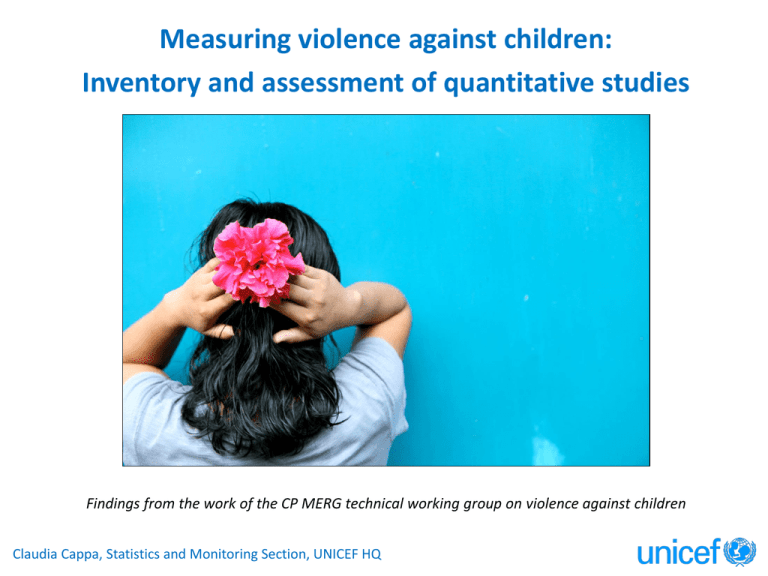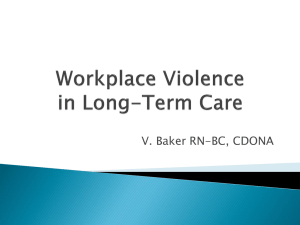
Measuring violence against children:
Inventory and assessment of quantitative studies
Findings from the work of the CP MERG technical working group on violence against children
Claudia Cappa, Statistics and Monitoring Section, UNICEF HQ
Objective and content
• Present results of an assessment of VAC studies
commissioned in 2012 by the Technical Working Group
(TWG) on Violence against Children (VAC) of the global Child
Protection Monitoring and Evaluation Reference Group (CP
MERG)
• Provide an overview of data availability on VAC, methods
and protocols used to collect data
• Discuss some of the challenges related to the collection of
data on VAC
CP MERG
Technical Working
Group
on Violence
against Children
Background
• Part of the CP MERG
• Established in April 2011
• 8 members: ILO, Save the Children, Pop Council, ChildFund,
Plan International, EU FRA, ICF MACRO, UNICEF
• Chaired by UNICEF
• More information available at: http://www.cpmerg.org/
Rationale
• Proliferation of different measurement efforts aimed at filling
the existing gaps, primarily using large-scale populationbased surveys
Absence of commonly agreed operational definitions of VAC and
standardized data collection tools
• Different standards and practices for protection of
respondents and interviewers, and follow-up support to
victims
Absence of ethical guidelines on data collection on VAC
Goal and objectives
Goal: assist countries/partners in their efforts to gather
reliable, useful, comparable and ethically sensitive data on VAC
Objectives: Development of guidelines for the collection of
data on VAC
• Technical guidelines aimed at maximizing the disclosure of
actual violence and at guaranteeing high quality data
• Ethical guidelines aimed at minimizing the risk of potential
harm to respondents, interviewers and others, resulting
from the data gathering process
2012 outputs
• Conducted a literature review on research ethics and risks
associated with data collection on violence against children
• Conducted an inventory and a critical assessment of data
collection efforts to identify existing self-report survey tools
and methods that are being used or are under development
in the area of violence against children
Two publications, first released in October (literature
review) and to be released in December (assessment)
Next steps
• Development of guidelines for data collection on
violence against children
• Intended for use by NSOs and other agencies that
want to gather data on VAC
• Training material and workshops on the guidelines
Inventory and assessment of quantitative
studies on VAC : methods
Steps and components
• Key informant interviews
• Inventory and description of quantitative studies on VAC
44 studies + leads to additional 21 studies
• In-depth assessment of 7 studies (UK, Georgia, India,
Moldova, Tanzania, Eastern Caribbean, Chile)
Elements covered in the assessment
•
•
•
•
•
•
•
Commissioning and implementing agencies
Definitions and indicators
Sample designs
Research protocols
Ethical protocols
Field coordination
Quality control and data processing
Limitations
• Review only includes studies that are publicly available and
for which some background documentation was found =
not meant to be exhaustive
• Data quality not part of the assessment (access to datasets
not granted in most cases)
• Review of prevalence estimates not part of the assessment
(results are largely non comparable)
• Assessment of usefulness for programs and impacts of the
studies not included
Inventory and assessment of quantitative
studies on VAC : content
Basic characteristics
• 36 studies had a specific focus on VAC (stand alone
studies)
• 8 studies were general surveys with modules or
questions on VAC
- 4 national surveys
- 4 part of international programs (MICS, DHS, GSHS, HBSC)
• 34/44 were meant to be representative at the
national level
International survey programs
International survey programs
Number of surveys with questions/modules on violence by survey type
90
80
78
70
60
50
50
37
40
34
30
20
10
0
MICS surveys with a
module on child discipline
GSHS surveys with
questions on violence
HBSC surveys with
questions on violence
DHS surveys with a
module on violence
against girls and women
MICS data on child discipline
• Data on child discipline collected since 2005-2006
• Questions addressed to family relatives/mothers or primary caregivers of
one randomly selected child aged 2 to 14 years old
• The questionnaire asked whether any member of the household had used
any of various disciplinary practices with that child during the past month
• 8 violent disciplinary practices: 2 psychological (such as shouting and
name calling); 6 physical (such as shaking, spanking and hitting with an
implement)
• 3 non-violent disciplinary practices (such as taking away privileges and
explaining why something is wrong)
• Assesses mother/primary caregivers’ attitude toward physical punishment
Global School-based Student Health Surveys:
Methodology and questionnaire
•
Developed by the WHO and CDC
•
School-based surveys of children aged 13-15
•
Not conducted at regular intervals but implemented upon request from countries
•
Standard GSHS contain three VAC-related questions:
one about physical violence (involvement in physical fights)
two on bullying (being bullied and bullying others).
•
In its expanded version, the GSHS questionnaire also includes questions on:
– dating violence
– physical attacks
– sexual abuse
– carrying of weapons
– perception of safety and
– physical violence by teachers
Health Behavior in School-aged Children Study
• HBSC initiated in 1983 in 3 countries and soon after became a
World Health Organization collaborative study
• Now 43 member countries in Europe and North America and a
network of more than 350 researchers
• Conducted at regular intervals (last round 2009-2010)
• School-based surveys of children (average sample size of 1,550
for each age group - 11, 13 and 15 year olds)
• The standard HBSC contain three VAC-related questions:
- one about physical violence (involvement in physical fights)
- and two on bullying (being bullied and bullying others)
DHS indicators on violence
Data first collected in 1990, standardized in 1998-1999
Collects data on women aged 15-49 through an optional domestic
violence module
• Percentage of women aged 15-49 who have ever experienced
different forms of violence, by current age
• Percentage of women aged 15-49 who have ever experienced
physical violence since age 15 and who experienced any physical
violence in the past 12 months (age group 15-19 available)
• Percentage of women aged 15-49 who have ever experience
physical violence during pregnancy
DHS indicators on violence (con’t)
• Percentage of women aged 15-49 who have experienced
sexual violence by age at first experience of sexual violence
• Percentage of women aged 15-49 whose first experience of
sexual intercourse was forced, by age of first forced sexual
intercourse
• Percentage of women aged 15-49 who have ever (including in
childhood) experienced sexual violence and who experienced
any sexual violence in the past 12 months (age group 15-19
available)
DHS indicators on violence (con’t)
Spousal violence
• Percentage of ever-married women age 15-49 years by
whether they have experienced physical, sexual or
emotional violence committed by their current or most
recent husband/partner, ever and any in the past 12
months
• Further info available on frequency of violence
experienced in past 12 months and help-seeking
behaviour (disaggregated by age groups)
Overview of country studies
Years and frequency of implementation
• Among the 40 national studies :
12 conducted in 2008 alone
9 conducted after 2008, the latest in 2011
19 studies conducted before, the earliest in
2002-2003
• 36 of the 40 national studies were conducted just
once
Coverage by region
Number of national studies by region
14
12
12
10
10
8
6
5
4
4
2
4
3
2
0
Industralized
Countries
Middle East
and North
Africa
Eastern
Europe
Latin America West and
Eastern and
and Carribean Central Africa
Southern
Africa
Note: This table does not included countries that collected data on VAC through MICS, DHS, GSBS or HBSC.
Asia and
Pacific
Coverage by country
Number of national studies by country and region
Industrialized countries
Germany
UK
2
1
1
Middle East and North Africa
Jordan
Lebanon
Morocco
3
1
1
1
Eastern Europe
Armenia
Georgia
Moldova
4
1
2
1
West and Central Africa
Gambia
Ghana
Guinea
Mali
5
1
2
1
1
Asia and Pacific
China
Fiji
India
Kiribati
Malaysia
Maldives
Philippines
Solomon Islands
Timor-Leste
Vanuatu
Viet Nam
12
1
1
1
1
1
1
2
1
1
1
1
Eastern and Southern Africa
Ethiopia
Kenya
Malawi
Swaziland
Tanzania
Uganda
10
2
1
2
1
1
3
Latin America and Caribbean
Dominican Republic
Eastern Caribbean Multi Country Study
Chile
Mexico
4
1
1
1
1
Note: This table does not included countries that collected data on VAC through MICS, DHS, GSBS or HBSC.
Commissioning and implementation
• Of the 40 national studies identified, most were commissioned by
government agencies (19), followed by NGOs (10), international
organizations (11) and academic institutions
• Most of the studies conducted before 2006 were undertaken by
research institutions or NGOs. During and after 2006, 31 studies
were conducted with governments’ participations
• Little information on the identity of the organization or individuals
implementing the survey. When information is available, most
studies conducted by a (team of) consultants
• Few studies used the same teams of consultants
Some information on the study design
• Most studies were household surveys, few school based
• Full questionnaire available for only 15 of the studies
• In 16 studies self-administered questionnaire, 11
interviews, rest unknown
• Respondents: children from age 5 (mostly adolescents)
and adults (as victims and as perpetrators)
Definitions and indicators
• Vast majority of the surveys identified in this review
used their own definitions (15)
• In a few cases, definition used reflected national legal
framework (3)
• Frequent references to the CRC (24)
• Some references to the WHO definitions of violence
and abuse (5)
• Rationale for selection the target population or
definitions not given in most cases (17)
Questionnaire design
• Majority of surveys developed/used own tools
• 12 studies relied on modified versions of the CTS or
ICAST
• Limited information on how the tools were
developed and selected
– Cognitive testing= no information/not done
– Field testing of the questionnaire prior to survey
implementation = no information/not done
– Pilot testing in 27 cases
Types of violence covered
40
35
30
34
28
25
25
22
20
15
11
10
7
5
0
Physical violence Sexual violence
Emotional
violence
Corporal
punishment
Neglect
Bullying
Types of violence covered
Physical abuse
Corporal punishment
Sexual abuse
X
Emotional abuse
X
X
Neglect
Bullying
No. of Studies
4
X
1
X
1
X
X
X
X
X
1
X
2
X
4
X
X
X
X
X
X
X
X
X
X
X
X
2
2
X
2
4
X
X
X
X
X
X
X
X
X
X
X
X
X
X
X
X
X
X
X
X
X
X
X
X
X
X
2
3
2
X
1
2
2
1
X
4
Questionnaire content
• Content: experience of violence (35), attitudes
(4), perpetuation (3)
• Most surveys collected information of lifetime
experience of violence, 12 surveys collected
information on recent experience of violence (12
months, 6 months or last month)
• Risk/protective factors: data collected in 3 cases
only
Sample design
Sample type
No. of studies
Purposive sample
2
Convenience sample
7
No information
5
Cluster sample
3
Other random sample
22
Client sample
1
A ‘client sample’ was used in the study Child Sexual Abuse in Lebanon: the sample consisted of a random selection of children who visited a certain
community centre or summer camp.
Implementation
• Length of training for the field teams
unknown: 23 studies
two weeks: 4 studies
3 to 7 days: 8
1 or 3 days: 5
• Content of the training largely unknown
• Interviewers’ profiles: unknown for 35 studies, general interviewers
for most countries, social workers in 1 countries
• Teams composition and size: largely unknown (information
available for 8 studies only)
Quality control measures
and data quality tables
Callback
procedures
Interviewer’s
checks
Supervisor’s
checks
Data entry
software
Double blind
data entry
Information available for only three studies
No detailed data quality tables in the available reports
Ethical protocols: consent forms
Universe of the study
Child
sought?
consent
All children going to school in Georgia
Yes
All children aged 11-17
Yes
No
National Study on Violence against Children in Georgia (substudy: Children aged 11-17)
All children aged 12-19
Yes
Yes, caregiver
Adolescent Sexual and Reproductive Health in Ghana
All children aged 5-18 years
Yes
Yes
(directors
schools, parent)
All children aged 12-19
Yes
Yes, caregiver
Adolescent Sexual and Reproductive Health in MalawiResults from the 2004 National Survey of Adolescents
All school children aged 10-18 years
Yes
Yes, teachers
SUFFERING AT SCHOOL: Results of the Malawi GenderBased Violence in Schools Survey
Children aged 16-17 in the selected
Yes
locations
Yes, caregiver
Protect me with love and care: Fiji, Kiribati, Solomon Islands,
Vanuatu
All students in grade 1 and upwards
Yes
visiting public schools
No
A Baseline Study on Violence Against Children in Public
Schools in the Philippines
Males and females aged 13-24 years
Yes
Yes,
caregiver/household
head
Violence Against Children in Swaziland; Tanzania
All children aged 12-19
Yes
Yes, caregiver
Adolescent Sexual and Reproductive Health in Uganda:
Results from the 2004 National Survey of Adolescents
Secondary school children aged 13-15
No
Yes, head teacher
Uganda Global School Based Student Health Survey
All children aged 11-17
Yes
Yes, caregiver
Child abuse and neglect in the UK today (sub-study: children
aged 11-17)
All children in grade 8 or higher
Yes
Yes, school authorities
Violence in the Maldives (sub-study: School Survey)
and caregivers
Adult consent sought? Survey name
Yes
(directors
of
National Study on School Violence in Georgia
schools and parent)
of
Study on Child Abuse in India
Inventory and assessment of quantitative
studies on VAC : main findings and conclusions
Inventory and assessment on VAC
surveys: main findings
• Highly fragmented research sector
• Overall, the quality of the studies to vary to a very high degree
• Key terms defined on an ad-hoc basis that was unique to each
specific study
• Absence of a clear (theoretical) research framework
• Most studies conducted only once
Inventory and assessment on VAC
surveys: main findings (cont)
• Research designs and ethical protocols developed from
scratch
• No
validation
nor
instruments/methods
proper
field
testing
of
• Choice for or against specific approaches not discussed or
were justified ex post
• Limited information on ethics and overall limited
supporting documentation
Thank you
ccappa@unicef.org










